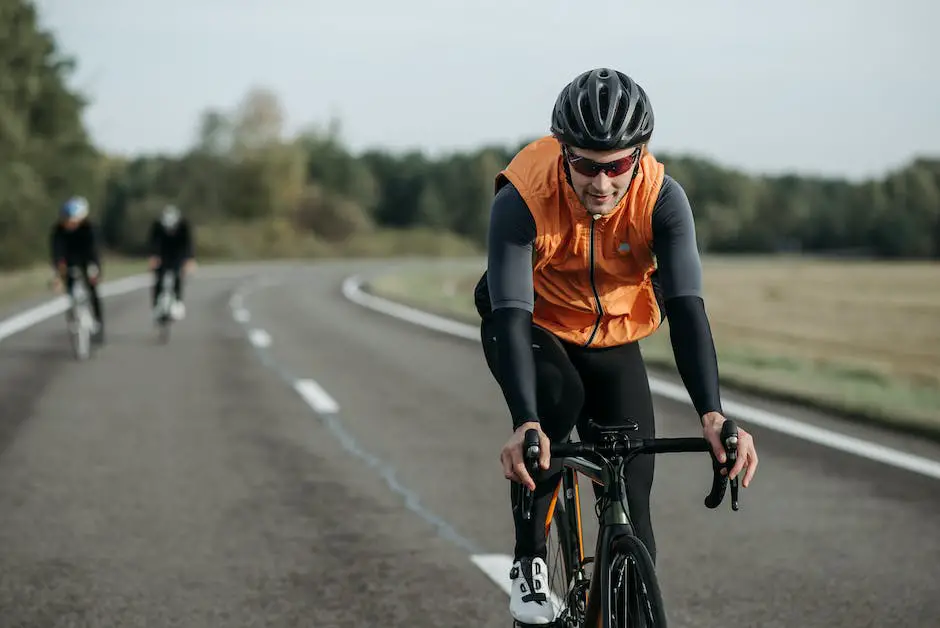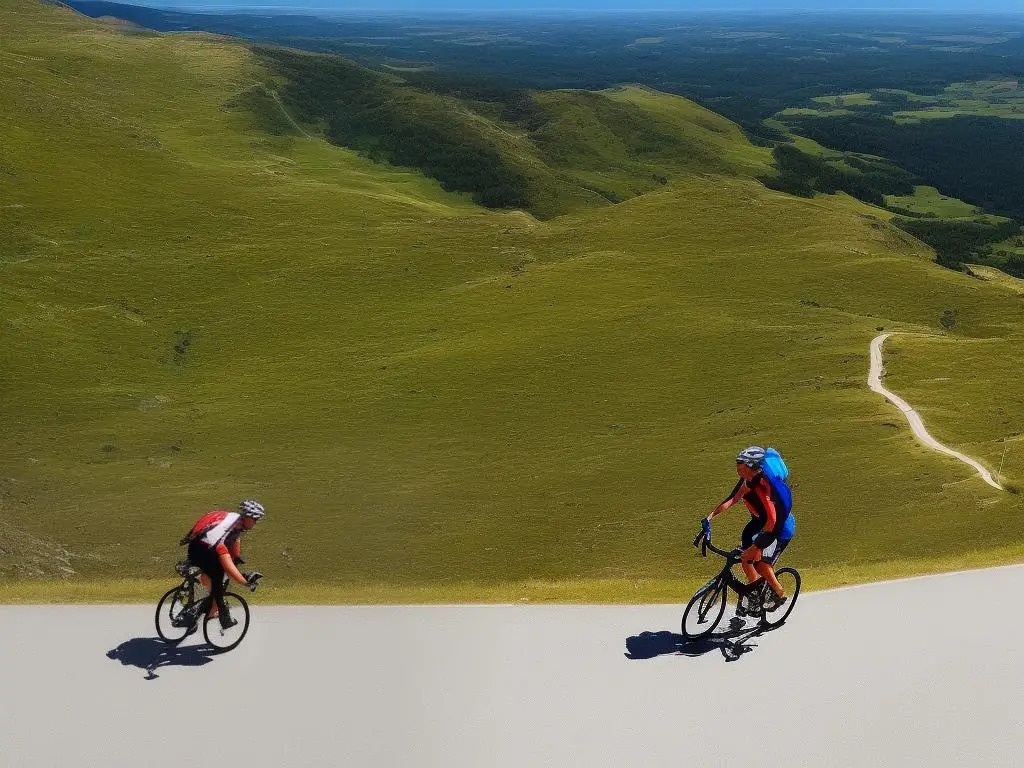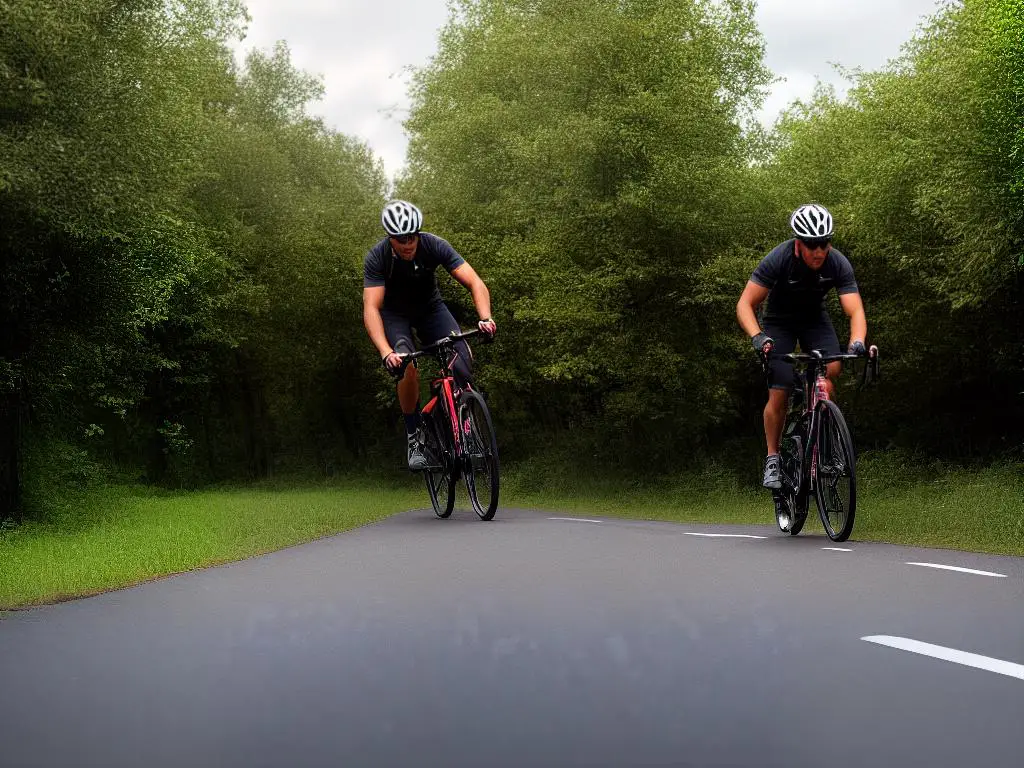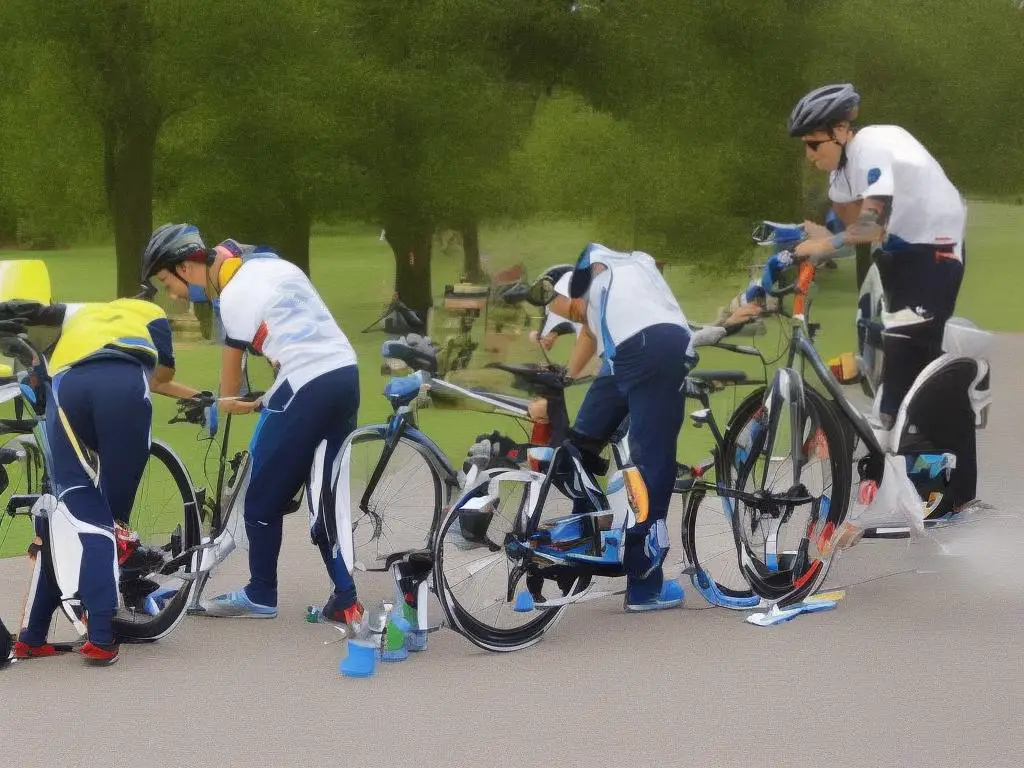Boost Your Cycling Endurance: Tips for Gradual Mileage Increase
Cycling is an enjoyable and efficient way to improve your physical fitness, explore your surroundings, and connect with a supportive community of fellow enthusiasts. As you embark on your journey to become a more confident and accomplished cyclist, it’s essential to master various aspects of the sport, including proper technique and equipment, training plans, and nutrition. In this comprehensive guide, you’ll find expert advice on everything you need to know about gradually increasing cycling miles and enhancing your overall performance.
Understanding Basic Cycling Techniques
Learning how to ride a bike is an essential skill that can help you enjoy the outdoors, stay fit, and explore new paths. Gradually increasing cycling miles and gaining confidence in your abilities is crucial to becoming a better cyclist. To help you get started, here are some basic cycling techniques that focus on proper cycling posture, pedaling technique, and gear shifting.
1. Proper cycling posture:
-
Your saddle height should be adjusted so that your leg is almost fully extended at the bottom of the pedal stroke. This allows for better power transfer and reduces the risk of knee injuries. To find the right saddle height, place your heel on the pedal at the lowest position, and your leg should be straight.
-
Your handlebars should be positioned at roughly the same height as the saddle or slightly below it depending on your comfort level. A lower handlebar position will generally provide a more aerodynamic position, while a higher handlebar position offers more comfort and control.
-
Keep your back relatively straight and lean forward slightly to distribute your weight evenly between the saddle and handlebars. Keep your elbows slightly bent to absorb shock and prevent upper body fatigue.
-
Place your hands on the handlebars in a comfortable position, usually on the brake hoods, with your fingers ready to operate the brakes and gear shifters. This will allow for better control and an easier reach for shifting gears.
2. Pedaling Technique:
-
Proper pedaling technique involves applying even pressure throughout the entire pedal stroke in a smooth, circular motion. This allows for better energy efficiency and greater speed.
-
Aim to maintain a consistent cadence (pedal revolutions per minute) of around 80-100 RPM. This will help reduce fatigue and prevent excessive strain on your leg muscles.
-
Practice “ankling” by extending your ankle at the bottom of the pedal stroke and flexing it at the top. This technique can help to engage different muscle groups and promote a smoother, more efficient pedal stroke.
3. Gear Shifting:
-
Understand your bike’s gearing system: Most bikes have multiple gears that can be adjusted using the shifters on the handlebars. The left shifter controls the front gears (chainrings) while the right shifter controls the back gears (cassette).
-
Anticipate your gear changes: Shift gears before you encounter a change in terrain, such as a hill or a sudden stop. Shifting gears while under heavy load or pedaling hard can cause the chain to slip and potentially damage your derailleur.
-
Use the right gear for the terrain: In general, use a higher gear (larger chainring and smaller cassette cog) for flat terrain and a lower gear (smaller chainring and larger cassette cog) for hills or challenging conditions. Experiment with different gear combinations to find the best one for your current riding situation.
-
Keep your chain clean and well-lubricated to ensure smooth gear shifts and reduce wear on your drivetrain components.
By following these basic cycling techniques, you’ll gradually gain the skills and confidence needed to tackle longer and more challenging rides. Remember to always wear a helmet, follow the rules of the road, and be mindful of traffic conditions. With practice and patience, you’ll soon become a more efficient and comfortable cyclist. Happy riding!

Developing a Training Plan
Developing a Training Plan for Gradually Increasing Cycling Miles
Here are some steps you can follow to create a cycling training plan that will help you reach your goals.
Step 1: Assess Your Current Fitness Level
Evaluate your current fitness level and comfort with cycling. Think about how far you can ride now and how often you ride. This will be your starting point for your training plan.
Step 2: Set Your Goals
Set specific, measurable, achievable, realistic, and time-bound goals for cycling. Make sure they are challenging yet attainable to stay motivated throughout your training.
Step 3: Break Down Your Goals into Weekly Milestones
Create smaller goals from your long-term goals. Break them down into weekly or bi-weekly targets, which makes it easier to achieve. This protocol ensures your body adapts to longer rides and prevents injury.
Step 4: Create A Structured Weekly Training Plan
Develop a weekly training schedule that includes short, moderate, and long rides, as well as rest days. Along with warm-up and cool-down periods, cross-training activities like strength training or yoga can improve cycling performance.
Step 5: Track Your Progress
Record your mileage, time, and perceived effort after every ride. This data can help you monitor progress and make changes to your plan if needed. Record keeping can be an excellent source of motivation as you watch your mileage grow.
Step 6: Listen to Your Body and Adjust Your Plan as Needed
Recognize the signals of overtraining or injury. Scale back your training, increase rest days, or adjust your goals as needed to strike a balance between progress and injury prevention.
Step 7: Assess Your Progress Regularly and Adjust Your Goals
Reevaluate every few weeks to determine where you stand relative to your goals and adjust your training accordingly. This way, you can be sure to stay on track and motivated.
Step 8: Stay Motivated and Enjoy the Ride
Finally, don’t forget to enjoy your time on your bike. Participate in group events, share your progress with friends, and connect with other cyclists to stay motivated and keep the fun in cycling.

Incorporating Rest and Recovery
Title: Incorporating Rest and Recovery in Gradually Increasing Cycling Miles
Introduction:
As an enthusiast or hobbyist looking to improve your cycling miles, it’s important to understand that rest and recovery are crucial components of your training program. In order to prevent injury and promote progress in endurance, you need to strike the right balance between pushing yourself and allowing your body to recover. In this guide, we’ll discuss the importance of rest days and active recovery, as well as tips on how to incorporate them into your cycling routine.
1. Understand the importance of rest days
- Rest days are essential for both physical and mental recovery. They give your muscles, joints, and connective tissues time to repair and strengthen, reducing the risk of injury and promoting muscular endurance. Additionally, rest days provide mental breaks from your training, which can help prevent burnout and maintain motivation.
- Schedule at least one full rest day per week, and consider taking two if you’re cycling high miles or intensifying your workout.
- Listen to your body and don’t be afraid to take additional rest days if needed. Signs that you may need more rest include persistent fatigue, muscle soreness, or a decrease in performance.
2. Practice active recovery
- Active recovery involves low-intensity, low-impact activities that increase blood flow and aid in muscle repair and recovery. Incorporating active recovery into your cycling schedule can help prevent injury, improve endurance, and maintain motivation.
- Some examples of active recovery activities include:
- Gentle stretching or yoga
- Walking or light hiking
- Swimming or water aerobics
- Foam rolling or self-myofascial release techniques
- Try to incorporate at least one active recovery day per week, and consider adding more if you’re feeling especially sore or fatigued.
3. Prioritize sleep
- Adequate sleep is crucial for recovery, as it gives your body the time it needs to repair and regenerate muscle tissue.
- Aim for at least 7-9 hours of sleep per night, and consider adding an extra 30 minutes to 1 hour on days when you’ve had an especially intense workout or are feeling particularly fatigued.
4. Maintain proper nutrition and hydration
- Proper nutrition and hydration are key components of recovery, as they ensure you’re providing your body with the necessary nutrients and electrolytes to repair and strengthen muscle tissue.
- Focus on consuming a balanced diet with an emphasis on lean proteins, complex carbohydrates, healthy fats, and plenty of fruits and vegetables.
- Additionally, drink plenty of water throughout the day, aiming for at least 8-10 glasses a day or more depending on your cycling activity.
5. Use periodization in your training program
- Periodization is a systematic approach to training that involves gradually increasing the volume and intensity of your cycling workouts over time, followed by a reduction in workload to allow for recovery.
- This can help prevent injury and promote progress in endurance by allowing your body to adapt to the increased demands of your training program.
- Consider working with a coach or using a predetermined cycling training plan to help you structure your workouts and incorporate rest and recovery periods effectively.
Conclusion:
Incorporating rest and recovery into your cycling routine is vital for preventing injury and promoting progress in endurance. By scheduling regular rest days, practicing active recovery, prioritizing sleep, maintaining proper nutrition and hydration, and using periodization in your training program, you’ll be setting yourself up for long-term success and enjoyment in your cycling endeavors.

Nutrition and Hydration for Cycling
Title: Nutrition and Hydration for Cycling: Fueling Your Body for Enhanced Performance
Introduction:
As a cycling enthusiast, you may have realized that increasing your cycling miles requires more than just physical training. Along with a solid cycling regimen, proper nutrition and hydration play a crucial role in supporting your body’s needs during long rides and improving overall cycling performance. In this guide, we’ll provide essential tips and strategies to optimize your nutrition and hydration, so you can stay energized, recover faster, and perform better on your bike.
1. Pre-Ride Meal Planning:
To sustain energy levels and maintain peak performance throughout your ride, it’s essential to consume a nutritious pre-ride meal. Aim for a meal that consists of a balance of carbohydrates (for energy), protein (for muscle repair), and healthy fats (for sustained energy release). A good pre-ride meal could include:
- Whole-grain toast with avocado and eggs
- Oatmeal with fruits, nuts, and a scoop of protein powder
- A nutritious smoothie made with fruits, vegetables, and a quality protein source
Consume your pre-ride meal about 2-4 hours before your ride to allow for proper digestion.
2. Fueling During the Ride:
For rides lasting longer than 90 minutes, it’s essential to consume additional carbohydrates to maintain energy levels. Portable and easy-to-digest options include:
- Energy gels or chews
- Dried fruits, like raisins or apricots
- Simple carbohydrate-rich snacks, like bananas or pretzels
Remember also to listen to your body; eat when you feel hungry, but try to consume small amounts every 30-45 minutes to prevent overeating and stomach discomfort.
3. Post-Ride Nutrition:
After completing a long ride, focus on consuming a recovery meal rich in carbohydrates (to replenish glycogen stores) and protein (to repair muscles). Some ideal post-ride meals or snacks are:
- Chocolate milk, which contains a good balance of carbohydrates and protein
- A turkey and cheese sandwich on whole-grain bread with some leafy greens
- Greek yogurt with fruit and a drizzle of honey
Aim to eat your post-ride meal within 30-60 minutes after finishing your ride for optimal recovery.
4. Hydration:
Staying hydrated is essential when cycling long distances. Dehydration can lead to fatigue, diminished performance, and even serious health issues. Here are some hydration tips:
- Start your ride well-hydrated by drinking plenty of water, as well as a glass of water or an electrolyte drink within 30 minutes before your ride.
- Carry a hydration pack or water bottles on your bike and aim to drink about one 16-ounce bottle of water or electrolyte drink per hour of riding, adjusting for factors like weather, exertion level, and personal sweat rate.
- Listen to your body, and drink when you’re thirsty. Don’t force yourself to drink beyond your comfort, but make sure you’re consuming enough fluids to prevent dehydration.
5. Electrolyte Replacement:
During long rides, especially in hot weather, you lose important electrolytes, like sodium and potassium, in your sweat. To prevent muscle cramps, weakness, and other symptoms of electrolyte imbalance:
- Include electrolyte drinks or sports drinks in your hydration routine, which contain a balanced mix of electrolytes.
- Consider using electrolyte supplements like tablets or powders, which can be mixed with water.
- Snack on potassium-rich foods like bananas and potassium-rich sports snacks during your ride.
Conclusion:
By following these guidelines for nutrition and hydration, you’ll be better prepared to tackle longer rides and continually increase your cycling miles. Proper fueling and hydration will help you maintain energy levels, prevent muscle breakdown, and support overall cycling performance. Remember to listen to your body, adjust for individual needs and preferences, and enjoy the journey of becoming a stronger and more efficient cyclist.

Cross-Training and Strength Training
Cross-Training and Strength Training for Cycling Enthusiasts
Cross-training and strength training are essential components for improving your cycling skills, overall fitness, and promoting injury prevention. By incorporating a variety of exercises, you can work on different muscle groups, enhance your endurance, and support your cycling goals. Follow these instructions to create a balanced cross-training and strength training routine.
1. Develop a weekly workout schedule:
- Schedule 2 to 3 cross-training sessions per week, in addition to your regular cycling routine.
- Include 1 to 2 strength-training sessions into your workout plan.
- Ensure that you have at least 1 to 2 recovery or rest days for proper muscle recovery and to prevent overtraining.
2. Choose your cross-training activities:
- Consider activities that provide a balance to your cycling exercises, such as running, swimming, hiking, or even yoga.
- Engage in exercises that work on different muscle groups by combining various fitness disciplines like cardio, strength, flexibility, and balance.
3. Begin your cross-training routine with a proper warm-up:
- Perform light aerobic exercises, such as jogging or jumping jacks, for about five minutes to increase your heart rate and prepare your muscles for the workout.
- Follow with dynamic stretches, targeting the major muscle groups, such as leg swings, arm circles, and trunk rotations.
4. Incorporate functional strength training exercises:
- Focus on compound movements that engage multiple muscle groups simultaneously, like squats, lunges, push-ups, and planks.
- Add some cycling-specific strength exercises, such as single-leg squats and deadlifts, to improve your pedal stroke and power.
- Utilize your bodyweight, resistance bands, or free weights to add resistance and challenge your muscles.
5. Core work is essential for cyclists:
- Strengthen your core muscles (lower back, abdominals, and obliques) to improve stability on the bike and reduce the risk of injury.
- Perform exercises like planks, side planks, bird-dog, and bicycle crunches to target the different core muscle groups.
6. Don’t forget about flexibility:
- Include stretching exercises in your routine to improve your range of motion and flexibility, which can help prevent injuries and boost your cycling performance.
- Practice static stretching or yoga after your workouts, focusing on the major muscle groups like hamstrings, quadriceps, hip flexors, and calves.
7. Monitor your progress and adjust your routine accordingly:
- Keep track of your workouts, how you feel, and improvements in your cycling abilities, such as increased mileage, speed, or hill climbing.
- Adjust the intensity, frequency, or duration of your cross-training and strength training sessions based on your progress, goals, and preferences.
8. Listen to your body:
- Take rest days, modify your exercises, or consult a healthcare professional if you experience pain, discomfort, or signs of overtraining like persistent fatigue and decreased performance.
By incorporating cross-training and strength training into your regular cycling routine, you’ll notice improvements in your overall fitness level and cycling performance. Stay consistent, challenge yourself, and enjoy the journey to becoming a stronger cyclist.

Preventing and Addressing Common Cycling Injuries
Title: Preventing and Addressing Common Cycling Injuries
Introduction: Cycling is a fantastic way for enthusiasts and hobbyists to stay fit and have fun while exploring the outdoors. However, cycling also carries the risk of certain injuries. To ensure you remain injury-free while gradually increasing your cycling miles, it’s important to learn about common cycling injuries, how to prevent them through proper technique and equipment, and how to address them if they occur. Here are some instructions to help you on your journey.
1. Overuse Injuries:
One of the most common types of cycling injuries are overuse injuries, which include iliotibial (IT) band syndrome and patellar tendonitis.
Prevention:
- Gradually increase your cycling miles to give your body time to adapt.
- Maintain a proper bike fit, ensuring a comfortable seat height, handlebar height, and saddle position.
- Include rest days in your training schedule to allow your muscles to recover.
- Wear appropriate footwear and use insoles to support your foot arches.
- Practice proper cycling technique, such as maintaining a consistent cadence and using your hamstrings and quadriceps efficiently.
Addressing:
- If you experience pain or discomfort from an overuse injury, take a break from cycling until the pain subsides.
- Apply ice to the affected area for 15-20 minutes several times per day.
- Consider physical therapy or a sports massage to alleviate muscle tightness.
- Perform targeted strengthening and stretching exercises to gradually return to cycling.
2. Sprains and Strains:
Sprains and strains often occur due to sudden movements or falls while cycling.
Prevention:
- Keep your bike properly maintained to reduce the risk of accidents.
- Ride cautiously and avoid unexpected obstacles.
- Improve your overall cycling technique for better balance and control.
- Wear protective gear, such as gloves and padded shorts, to minimize injury during falls.
Addressing:
- If you develop a sprain or strain, follow the RICE method – Rest, Ice, Compression, and Elevation.
- Over-the-counter pain medications such as ibuprofen can help reduce inflammation and pain.
- After the first few days, gradually introduce gentle stretching and strengthening exercises.
- Seek medical advice if the pain worsens or there is no improvement after a few days.
3. Saddle Sores and Chafing:
Prolonged periods of cycling can lead to discomfort or sores due to friction between your skin and the bike saddle.
Prevention:
- Choose a saddle that suits your body shape and riding style.
- Wear cycling-specific padded shorts and apply a chamois cream to help reduce friction.
- Adjust your riding position to alleviate pressure on sensitive areas.
- Keep your skin clean and dry, and remember to change out of wet or sweaty clothes promptly.
Addressing:
- Clean the affected area with soap and water, and apply an over-the-counter antibacterial cream.
- Keep the area dry and wear loose-fitting clothing while it heals.
- If the sore becomes infected or shows no signs of improvement after a few days, seek medical advice.
4. Neck and Back Pain:
Long rides can lead to discomfort in the neck and back due to poor posture and bike fit.
Prevention:
- Ensure a proper bike fit by consulting with a bike fitting professional.
- Strengthen your core muscles for better posture and support.
- Regularly stretch your neck, shoulders, and back before and after cycling.
- Adjust your handlebars and saddle to achieve a comfortable riding position.
Addressing:
- Apply ice or heat to the affected area for pain relief.
- Try gentle stretching exercises to help reduce muscle tension.
- Consider getting massages or attending yoga classes to improve your flexibility.
- If the pain persists or worsens, consult with a medical professional or physical therapist.
Conclusion:
By keeping these preventive measures and treatment strategies in mind, you can greatly reduce your risk of common cycling injuries. Maintaining a proper bike fit, gradually increasing cycling miles, and following good self-care practices will ensure an enjoyable cycling experience. Stay safe and have fun on your cycling journey!

Bike Maintenance and Equipment
Title: Bike Maintenance and Equipment for EnthusiastsIntroduction: As a cycling enthusiast, maintaining your bicycle and choosing the right equipment is vital to ensure your rides are enjoyable and trouble-free. This guide aims at providing basic knowledge on how to maintain your bicycle, perform essential repairs, and select appropriate cycling gear.Section 1: Basic Bike Maintenance1.1 Cleaning Your Bicyclea. Assemble your cleaning supplies: A soft brush or sponge, an old toothbrush, a bucket of warm soapy water, a garden hose, and clean rags.b. Begin by removing any loose debris from your bicycle using a soft brush or sponge.c. Fill the bucket with warm soapy water and dip your brush or sponge. Start washing your bicycle, working from the top down, paying attention to the frame, wheels, and drivetrain.d. Rinse your bicycle gently with a garden hose, making sure not to use high-pressure water directly on bearings or any sensitive parts.e. Dry the bike with clean rags and let it air dry completely to prevent rust.1.2 Lubricationa. Lubricate the chain with a dedicated bike chain lubricant. Apply a small amount of the lubricant to each link, and use a rag to remove any excess.b. Inspect your bicycle’s gears and brake components for wear and lubricate them as necessary.c. Apply a light coating of grease to the bicycle’s seatpost before inserting it into the frame to prevent seizing.1.3 Basic Repairsa. Regularly inspect your bicycle’s brake pads and cables for wear. Replace the brake pads when needed and adjust the brake cables to ensure optimal performance.b. Check the tires for cuts, punctures, or excessive wear. Inflate them to the recommended pressure noted on the tire sidewall.c. Adjust the gears on your bicycle regularly, ensuring smooth shifting and minimal chain noise.d. Inspect your bicycle’s headset and wheel bearings for play. Tighten or service them as necessary.Section 2: Selecting Appropriate Gear2.1 Helmetsa. Choose a comfortable, well-ventilated helmet that meets safety standards. Make sure it fits snugly around your head without being too tight.b. Replace your helmet after a serious impact, even if there is no visible damage.2.2 Clothinga. Wear moisture-wicking, quick-drying fabrics to help regulate body temperature and prevent chafing.b. Opt for padded cycling shorts for added comfort during long rides.c. For cooler weather, consider wearing thermal clothing, arm and leg warmers, and a windproof jacket.d. Use sunglasses with UV protection to shield your eyes from the sun and potential debris.2.3 Cycling Shoes and Pedalsa. Select cycling shoes that offer a balance between comfort and efficiency. Look for a snug fit, breathable materials, and appropriate cleats for your chosen pedal system.b. Choose the right type of pedals based on your cycling preference (flat/platform pedals, clipless/SPD pedals, or toe-clip pedals).2.4 Hydration and Nutritiona. Invest in a quality water bottle or hydration pack to keep you hydrated during your rides.b. Carry energy bars, gels, or other small snacks to maintain energy levels for longer rides.Conclusion: By following these basic guidelines on bike maintenance and equipment, you will be well on your way to enjoying longer and more satisfying bike rides. Always inspect your bicycle and gear before heading out, and never hesitate to consult with professional mechanics or experienced cyclists when in doubt. Happy cycling!

Mental Strategies for Increasing Mileage
Title: Mental Strategies for Increasing Cycling Mileage: Overcoming Challenges and Staying Motivated
As a cycling enthusiast or hobbyist, there will be times when you want to push yourself to the next level and increase your cycling mileage. Developing your mental toughness and using effective mental strategies can be the key to overcoming challenges and staying motivated as you work towards your cycling endurance goals.
1. Set attainable goals:
Start by setting short-term goals that are challenging yet achievable. It’s essential to create realistic expectations and gradually progress towards your ultimate target. Break down your long-term goals into weekly or monthly milestones, and celebrate your achievements as you hit each milestone.
2. Visualize success:
Visualization is a powerful mental strategy that can help you stay focused on your goals and increase your self-confidence. Spend a few minutes every day picturing yourself achieving your cycling goals, whether it’s finishing a race or completing a specific distance. This will keep you motivated and build your belief in your ability to succeed.
3. Develop a strong mental inner dialogue:
Maintain a positive mindset and develop a strong mental inner dialogue to silence your inner critic when it tries to cast doubt on your abilities. Create motivational statements and affirmations that will help you push through moments of doubt, such as “I am strong and capable,” or “I can do this; I’ve trained hard and prepared for this challenge.”
4. Manage self-talk:
Stay aware of your self-talk during your rides, and make sure to keep it positive and encouraging. Avoid negative self-talk, as it can quickly lead to decreased motivation and performance. Remind yourself of your past accomplishments and use them as fuel when things get tough.
5. Utilize mental anchors:
Create mental anchors such as specific power words, symbols, or memories that you can draw upon during challenging moments to help you stay motivated. Examples include remembering the feeling of finishing your first long ride or associating a particular song with your determination to succeed.
6. Focus on the process rather than the outcome:
Instead of fixating on the final goal or your performance compared to others, focus on the process of building your endurance, cadence, and pedaling techniques. By concentrating on the elements within your control, you’ll maintain your motivation and avoid feeling overwhelmed.
7. Embrace the challenges:
Learn to see challenges as opportunities for growth rather than setbacks. Embrace the tough segments as they will only make you stronger and better prepared for future rides. Use your mental strategies to help you remain composed and accept the challenges with a positive outlook.
8. Celebrate small victories:
Take the time to acknowledge and celebrate your smaller achievements along the way, whether it’s increasing your ride duration or completing a particularly challenging climb. This will help you stay motivated and focused on your long-term goals as you recognize the progress you’re making.
9. Build a support network:
Surround yourself with other cyclists or friends who share your passion for the sport. Sharing your goals, challenges, and achievements with others can help you stay accountable and motivated. Joining a cycling group or participating in group rides is a great way to connect with other riders and make lasting friendships.
10. Reflect and adjust:
Regularly reassess your progress and evaluate your mental strategies. Reflect on what’s working well and identify areas for improvement in your approach to endurance cycling. Make adjustments as needed, and as you continue to grow and evolve as a cyclist, your mental strategies should also develop to align with your current goals and abilities.
Conclusion:
Developing mental strategies for increasing your cycling mileage is essential to overcome challenges, stay motivated, and achieve your cycling endurance goals. By nurturing a positive mindset, focusing on the process, and celebrating small victories, you can develop the mental toughness required to tackle higher cycling mileage targets and tackle new challenges with confidence.

Photo by davidmarcu on Unsplash
Group Rides and Cycling Community
Introduction:
Cycling is a fantastic way to stay fit, challenge yourself, and explore new territories. If you’re a cycling enthusiast looking to take your passion to the next level, consider joining group rides and becoming part of a cycling community.
Connecting with other cyclists provides numerous benefits, such as support, motivation, and camaraderie. In this article, we’ll discuss the advantages of riding with others and provide tips on how to increase your cycling miles while becoming part of a close-knit community of cyclists.
Benefits of Group Rides:
- Motivation and Accountability
When you ride with a group, you’re more likely to stay motivated and consistent in your cycling. Having scheduled rides with others creates a sense of accountability that can push you to show up and perform at your best. Furthermore, seeing fellow cyclists achieve their goals can inspire you to work harder and reach new milestones. - Improved Cycling Skills and Techniques
Riding with more experienced cyclists can help you improve your skills and techniques significantly. You’ll learn about proper cycling form, bike handling skills, and strategies for tackling challenging terrains. Picking up tips and advice from seasoned cyclists can greatly enhance your overall cycling experience. - Safety and Support
Group rides offer a safer and more supportive environment, especially for beginners. Riding with others ensures that you’ll have someone nearby to help if you encounter any issues, such as a flat tire or mechanical breakdown. Moreover, cyclists in a group are more visible to motorists, which can lead to a safer riding experience on busy roads. - Socializing and Camaraderie
Cycling with others provides an opportunity to make new friends and bond with fellow enthusiasts. Sharing your passion for cycling with others can create lasting friendships, as well as a strong sense of camaraderie within the group. This can make your cycling journeys even more enjoyable and memorable. - Discovery of New Routes and Challenges
Participating in group rides can introduce you to new cycling routes and challenges that you might not have encountered otherwise. Riding with a group allows you to explore unfamiliar areas with the guidance and expertise of local cyclists. Plus, tackling challenging terrains or attempting longer rides in a group can boost your confidence and encourage personal growth.
Tips for Gradually Increasing Your Cycling Miles and Participating in Group Rides:
- Start with Shorter Rides
Ease into group rides by participating in shorter, beginner-friendly rides. As you grow more comfortable cycling in a group and build your endurance, gradually increase the distance and intensity of your rides. - Research Local Cycling Groups and Rides
Search for local cycling clubs, groups, or organized rides in your area. Many groups have online forums or social media pages where you can find information about upcoming rides, routes, and skill levels. Select a group that best aligns with your goals and interests. - Properly Prepare for Your Rides
Ensure that your bike is well-maintained, and carry the necessary tools and supplies for each ride, such as a spare tube, pump, and multi-tool. Also, familiarize yourself with group riding etiquette and safety guidelines to ensure a smooth and enjoyable experience for everyone. - Set Realistic Goals
When working to increase your cycling miles, set achievable goals that align with your current fitness level and experience. Develop a training plan that allows for gradual progress, and avoid pushing yourself too hard too soon to prevent injury or burnout. - Be Patient and Persistent
Increasing your cycling miles and becoming part of a cycling community takes time and dedication. Stay patient and persistent in your efforts, and celebrate your progress along the way. With time and commitment, you’ll find yourself immersed in a supportive and motivating community of fellow cycling enthusiasts.
Conclusion:
Joining group rides and connecting with a cycling community can greatly enhance your cycling experiences. With the added benefits of motivation, support, and camaraderie, you’ll find yourself more eager to hit the pavement and explore new cycling challenges. Embrace this opportunity to grow as a cyclist and make lasting connections within your local cycling community.

By taking the time to understand and implement the various aspects of cycling, from proper technique to nutrition, you’ll be well-equipped to achieve your goals and experience the many benefits of this satisfying and life-enhancing pursuit. Remember, patience, consistency, and balance are critical to successfully increasing your cycling mileage and improving your fitness level. Stay persistent, enjoy the ride, and continue to learn and grow with the support of the cycling community.
